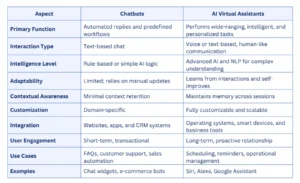The issue of chatbot vs virtual assistant has never been so important in relation to the artificial intelligence being used to transform business interactions. Whilst chatbots simplify customer service due to their ability to respond quickly based on tasks, virtual assistants offer personalized and context-based support for a variety of tasks. The distinction between chatbots and virtual assistants enables businesses to determine when to use chatbots in automation or virtual assistants in improving operational efficiency. Within this guide, we discuss the main differences, practical applications of chatbots to businesses and useful virtual assistant applications, and how smart artificial intelligence tools can make your organization rise to the next level.
What is Chatbot vs Virtual Assistant: The Digital Helpers Revamping Businesses?
The chatbot vs virtual assistant comparison has never been as topical as it is at present. The two technologies are transforming how businesses communicate, automate and serve their customers. They can appear to be similar at first sight, but their purpose, functionality, and impact are different. We will discuss their uniqueness and the role of each of them in contemporary business processes.
What is a Chatbot?
A chatbot is a computer-driven conversation system developed to simulate human interaction through text or speech. Think of it as your virtual frontier individual- it exists to answer questions, assist customers, or provide information in an instant. It might be a reservation inquiry, a check on the stock of an item, or even a solution session; AI chatbots do the job of an efficient virtual agent that never takes the day off.
The current chatbot business technology emphasizes the provision of timely, accurate, and safe help through various channels. They can handle customer interactions in large volumes so that no question remains unanswered.
Some of the prominent points of the AI chatbot vs virtual assistant features in connection with chatbots are as follows:
- Intelligent and responsive communication: Though advanced AI chatbots may be confronted with new or novel questions, they can extend their interaction with a meaningful conversation based on natural language processing (NLP).
- Information and lead generation: Chatbots can deduce users’ intentions and harvest valuable information, enabling businesses to maximize the generation of leads and learn marketing trends.
- 24/7 customer service: Round-the-clock customer service: Customer experiences: 24/7 customer service is one of the most applicable benefits of business chatbots since humans can handle complicated issues, and customers will not feel abandoned.
Briefly, chatbots are now included in AI customer service tools, and they allow businesses to remain responsive, efficient, and user-focused.
What Is a Virtual Assistant?
Between chatbot vs virtual assistant, virtual assistant, conversely, acts more as a digital personal assistant or an AI-driven executive partner. Suppose you had someone to take care of your appointments, to sort your emails and manage your smart home devices, as well as remind you of your future deadlines– that is precisely what a virtual assistant does.
Since Siri and Alexa, and Cortana, these virtual assistant apps are meant to comprehend natural language and execute operations using voice or textual commands. To the businesses, they are smart software applications that can increase productivity, workflow, and administrative tasks.
The key benefits of virtual assistants and their advantages to the business include:
- Better productivity and efficiency: Virtual assistants help organizations automate repetitive tasks, such as scheduling meetings or sending notifications, and spend time on high-priority work.
- Holistic assistance: Virtual assistants may meet all kinds of needs, including the administration of internal communications and client requests, which makes the daily functioning smoother.
- Improving daily life: In addition to businesses, virtual assistants make life easier, managing minor yet time-intensive tasks – making life more convenient and comfortable.
When it comes to the discussion chatbot vs virtual assistant, virtual assistants are distinguished by the possibility to work multitasking and assist with a wider scope of operations, whereas chatbots are superior in managing the customer-facing interactions.
Chatbot vs Virtual Assistant: Key Differences Every Business Should Know

The growing debate regarding chatbot vs virtual assistant will leave business owners wondering which is the most suitable solution to fit their specific needs. Both types of solutions utilize artificial intelligence, enabling a greater level of service to the customer and greater efficiency in operation for the company, but they are, however, very different in behavior, design, and intelligence quotient. Essentially, a virtual assistant is an intelligent digital companion that can perform many context-driven actions, while a chatbot is a limited and task-oriented automated communication tool. It is important to understand the difference before adding chatbots and virtual assistants to the company’s ecosystem.
Purpose and Functionality
Between chatbot vs virtual assistant, chatbots are efficiency-oriented. They give fast, automated, and usually scripted replies to frequent questions such as the availability of products, order tracking, or service requests. This renders them irreplaceable in AI customer service applications to handle large numbers of inquiries.
Nevertheless, the purpose of virtual assistants is much larger. They can multitask, which can include schedule management, emails, and controlling smart appliances, which makes them better suited to virtual assistants in business and everyday life.
Intelligence, Adaptability
There’s a huge difference between the intelligence of a chatbot vs virtual assistant. A chatbot typically uses a standard decision tree or a hard-wired rule. An AI virtual assistant, on the other hand, uses contextual learning and natural language processing as well as existing AI to interpret user intent and to learn while dealing with an individual. This eventually makes it possible to give back context-sensitive and individualized information.
Interaction Type and User Interface
If we compare chatbot vs virtual assistant, chatbots generally operate through text-based user interfaces, such as social media messengers, in-app popups, or web chat widgets. Their style of communication is efficient and clear.
Thus, the ability of virtual assistants to interpret voice and text commands gives them an impression of being more natural and conversational to use. Their versatility allows them to be used in situations where there is multitasking or a requirement for hands-free operations.
Difficulty and Level of Intelligence
The chatbots are simple, responding to FAQs, average intelligent bots with the ability to carry out transactions or lead generation. Nonetheless, there is logic behind them.
Virtual assistants are more complex by nature, as they can handle layered commands, handle context, and learn habits. They also change with each interaction, which is a sign of genuine artificial intelligence.
Personalization and Contextual Awareness
A significant distinction between chatbot vs virtual assistant is in the contextual management. Chatbots are more likely to process every interaction separately and forget about past interactions. However, virtual assistants do not discard the context of the conversation, making them continuous and responding in more coherent and natural human ways.
The personalization of their experiences makes them particularly useful for long-term customer engagement and virtual assistant business benefits.
Tailoring and Adaptability
Chatbots are domain-specific, and they provide little customization beyond programmed logic. They can be trained by businesses on specific tasks in a given workflow.
On the other hand, if you compare chatbot vs virtual assistant, virtual assistants are very flexible and can transform according to the user’s preferences. They are scalable individually and as part of complex eco-systems – between individual and organizational scale – both in terms of personal productivity systems and in terms of enterprise workflow.
Integration and Availability
In the chatbot vs virtual assistant comparison of business chatbots, they are typically integrated into online applications, such as websites, CRM systems, or e-commerce websites, to enable immediate interaction, which is an essential element of business operations.
Virtual assistants are a step further, being part of operating systems and intelligent gadgets (such as Siri, Alexa, and Google Assistant), with which they can interact across a variety of touchpoints.
Duration of Interaction with the User
Chatbots are more effective in task-oriented interactions, which are short-term and focus on transactions, i.e., quick discussions, that address the needs of the user instantly.
Nevertheless, virtual assistants create long-term relationships, are memory of user preferences, learn with time, and offer proactive help – not only by creating reminders, but also by managing business schedules.
Use Cases in Business
It is important to consider your business objectives when making a decision regarding the use of a chatbot or virtual assistant.
- Chatbots are effective in customer service, lead qualification, and automated interaction.
- Virtual Assistants excel in individual efficiency, operational support, and smart business automation.
Using the combination of both technologies via the services of professional AI development, businesses will have a golden mean of automation and personalization.
Choosing Between Chatbot vs Virtual Assistant: Which One Does Your Business Need?
The debate of chatbot vs virtual assistant keeps increasing in the world of artificial intelligence. Both have developed into vital business tools for increasing productivity, reducing workloads, and improving customer experiences. Whether they are automating customer service or optimizing internal processes, both systems are transforming how businesses communicate and function.
However, your specific business aims, capabilities, and audience needs will determine when to use chatbot vs virtual assistant. We can talk about the advantages of each technology and why your company would benefit more from one than the other.
The Reason to Use Chatbots in Your Business
A business chatbot may become a breakthrough in case your business is characterized by a high number of customers or the frequency of questions. If you look at chatbot vs virtual assistant, chatbots are designed to automate interactions that are task-specific, such as answering frequently asked questions, processing order questions, or providing other troubleshooting.
They can be particularly helpful to firms that do not require significant expenditure in human capital to provide AI customer service tools. AI chatbots improve customer satisfaction and operational efficiency as they are capable of providing consistent, fast, and correct answers.
There are numerous pragmatic benefits associated with the modern chatbot technology in business, which are apparent and practical:
24/7 Availability
Chatbots never sleep, unlike human actors. They guarantee 24/7 customer contact, contributing to the brand’s staying in touch with the users seamlessly in various time zones.
Cost-Effective Automation
Compared to a customer service team of significant size, the cost of creating a chatbot and implementing it is much cheaper. This renders chatbots an intelligent choice for business companies with constrained budgets.
Scalability Under Pressure
Chatbots work best in high-traffic applications like help desks, SaaS portals, and e-commerce stores because they can handle thousands of interactions at once without compromising the quality of the response.
Individual User Experience
In order to encourage engagement and loyalty, contemporary AI chatbots can study user behavior and provide contextual responses and tailored recommendations.
In a nutshell, chatbots can be effectively used by companies that need scalability, uniformity, and affordability. They are the best option where the intention is to provide real-time, stable, and organized customer experiences.
What Makes You Want Virtual Assistants in your Business?
Virtual assistants are the new direction when the need of the business surpasses the predetermined interactions and require a personal, more specific approach to assisting the client. In addition to scheduling meetings, these intelligent digital assistants also analyze data and offer proactive recommendations.
AI virtual assistants are a suitable alternative for companies that need to support complex decisions or automate internal procedures since, unlike traditional chatbots, they can think, learn, and adapt to the demands of users over time.
The way that companies and individuals manage time, communication, and productivity is changing as a result of virtual assistants. In the argument between virtual assistants and AI chatbots, this is what sets them apart:
Active Support and Intelligent Suggestions
Virtual assistants are not just reactive support. They learn about the user habits, mail logs, and time schedules to offer smart and proactive ideas– remind you of an upcoming meeting or the things you might like to travel.
Hyper-Personalized Interactions
One of the characteristics of the virtual assistant applications is the capability to learn over time. They analyze user preferences and history of behavior to provide hyper-personalized experiences, whether it is to suggest restaurants or to prioritize workflow tasks.
More Accessibility and Inclusivity
High accessibility features (including voice input, screen readers, and multilingual capability) are included in the newest virtual assistants. By serving users with varying requirements and backgrounds, this moves them closer to being more inclusive.
Multi-Modal Communication Capabilities
Today’s AI virtual assistants can read gestures, facial expressions, and even emotions, so they can comprehend more than just voice or text. This enhances the user experience by creating a natural human interaction.
Smooth Interconnectedness and Customizability
Contrary to chatbots, which are usually an add-on, virtual assistants are more deeply embedded into an ecosystem, e.g., a mobile operating system or enterprise workflow, and grow as a result of user feedback.
Chatbot vs Virtual Assistant: Making the Right Choice
The difference between chatbot and virtual assistant ultimately comes down to scope and sophistication.
Choose chatbots when your business needs automated, structured, and scalable customer communication.
Choose virtual assistants when your goals involve personalization, multi-functionality, and intelligent automation.
For many organizations, the most powerful strategy involves combining both technologies through professional AI development services. By leveraging chatbots for instant customer engagement and virtual assistants for complex task management, businesses can build an end-to-end intelligent automation ecosystem.
Conclusion
Choosing between a chatbot vs virtual assistant depends on your business goals: chatbots excel at automated, high-volume customer interactions, while virtual assistants deliver personalized, adaptive support. Leveraging both strategically can boost efficiency, customer satisfaction, and productivity. At AnavClouds Analytics.ai, we provide advanced AI development services, including tailored chatbots and virtual assistants, empowering businesses to automate workflows, enhance user engagement, and make smarter, data-driven decisions.



